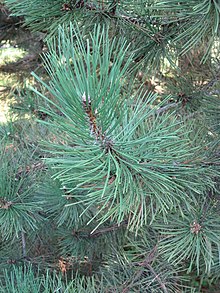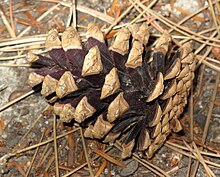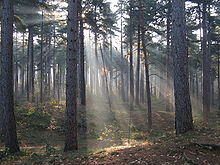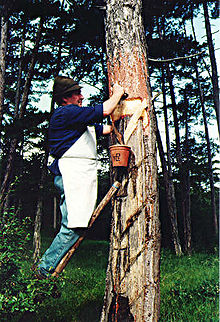Black pine
| Black pine | ||||||||||||
|---|---|---|---|---|---|---|---|---|---|---|---|---|
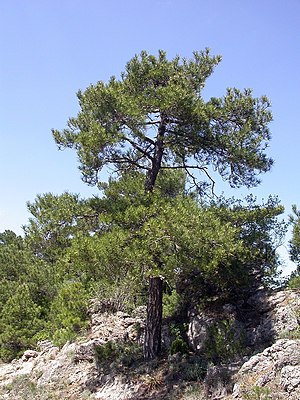
Pyrenees pine ( Pinus nigra subsp. Salzmannii ) in France |
||||||||||||
| Systematics | ||||||||||||
|
||||||||||||
| Scientific name | ||||||||||||
| Pinus nigra | ||||||||||||
| JFArnold |
The black pine ( Pinus nigra ), also called black pine , is a two-needle plant species from the genus of pine ( Pinus ) in the pine family (Pinaceae). It grows in the Mediterranean countries of southern Europe, Asia Minor and western North Africa and can be found in parts of Austria. Due to its modesty and its insensitivity to air pollution, it is planted almost worldwide as a forest and park tree. In its natural range, the species is also very disease-resistant. Today it is divided into five subspecies.
The black pine can reach an age of up to 800 years. One can easily distinguish the species from other southern European pine species by the black colored, hidden parts of the cone scales .
Because of its high resin content, it played an important role in bad luck . The wood is widely used and, since it does not creak, it is processed into stage floors, among other things.
description
Habitus
The black pine grows as an upright, mostly straight tree that can reach heights of growth between 20 and 50 meters and diameters of up to 1.85 meters at chest height . The height and shape of the crown vary depending on the subspecies and location. In general, trees on the eastern edge of the range form dense, broad-oval to umbrella-shaped crowns. The subspecies pallasiana , which is native to Turkey and has a narrow crown, is an exception . Young black pines usually have a slender crown that becomes rounded with age. The more the crown flattens, the less pronounced the initially regularly whorled branching. The branches are generally horizontal from the trunk, but in some subspecies they can be slightly bent up or down at the end.
Buds and needles
The light brown terminal buds are egg-shaped or cylindrical-egg-shaped and are between 12 and 24 mm long. They end in a distinctive tip and are, especially in the subsp. nigra , very resinous. The buds consist of numerous bud scales, around 5 mm long. At the base of the bud, these scales usually have a bent tip. In the subsp. pallasiana , the bud scales are usually 7 to 9 mm long and have fringed edges. The side buds are similar in shape and color to the terminal buds but are significantly smaller.
The light to deep green needles are between 4 and 24 cm long and 1.2 and 2.1 mm wide, depending on the subspecies and variety. There are two of them on short shoots . They are semicircular in cross-section and have 3 to 17 resin channels at the base . They usually grow straight or slightly curved. Needles of the subsp. laricio can be curved several times and rotated around the longitudinal axis. The apex is pointed, but not always sharp, and the edges of the needle are serrated. There are 12 to 24 rows of stomata on both the bottom and top of the needle . The needle bases are surrounded by a 10 to 20 mm long needle sheath. The needles remain on the tree between 3 and 8 years. The needle size as well as the needle morphology and anatomy are the most frequently used criteria for the taxonomic classification of the black pine, but are not sufficient to be able to draw geographical and taxonomic conclusions.
Flowers, cones and seeds
The black pine is single-sexed ( monoecious ) and becomes male at the age of 15 to 40 years . Depending on the location, it blooms between April and the beginning of June. The green colored male cones are heaped at the end of long shoots and are 2 to 3 mm long. The female cones are short-stalked and are in groups of two to four. They are initially green, but turn carmine red until they are pollinated. The 67 to 87 micrometer large, dumbbell-shaped pollen consists of a round-oval central body and two hemispherical air sacs on the sides.
The cones, which are 3.5 to 12 cm long and 2 to 4.5 cm thick, ripen in autumn of the following year. They are sessile or short-stalked and colored shiny brownish-yellow to light brown when ripe. They are at right angles or at a slightly inclined angle from the branch. The cone scales are heavily lignified and are between 2.5 and 3 cm long. The hidden parts of the cone scales are colored black, which distinguishes the black pine from other southern European pine species.
The slightly wedge-shaped, winged seeds are brownish gray to ash gray in color and are between 5 and 7 mm long. The wing is several times the length of the seed. The thousand grain weight is between 13.5 and 41.6 grams. Seedlings have 5 to 10 slim, imperforate and bald cotyledons ( cotyledons ). These become 2.5 to 3 cm long and fall off in autumn of the 1st year.
Chromosome number
The number of chromosomes is 2n = 24.
Root system
The black pine has a very extensive, robust root system with a strong and strictly geotropically growing taproot that anchors the tree firmly. The 1st order side roots grow horizontally, while the 2nd order side roots grow vertically. In rocky and largely soil-free locations, the majority of the roots are found in the upper soil layers. The roots even penetrate crevices in the rock and anchor the tree.
bark
Young trees have a brownish-gray, scaly trunk bark that tears open with age. The resulting plates are light-colored in trees of western origins, darker in color with almost black furrows in eastern origins. In old trees, the cracks are very deep and the plates are much larger than in young trees. In the laricio subspecies , the plates are almost evenly shaped. The bare and shiny young shoots change the color of their bark over the course of the growing season. The subspecies behave differently. In the subsp. laricio changes its color from an initial ocher yellow to a brownish red. Branches of the subsp. nigra have a brown rind with a gray to yellowish tone. In the subsp. pallasiana , the bark of the twigs is yellow to reddish brown in color.
Wood
The rather broad, yellowish-white sapwood stands out well against the darker and very resinous heartwood . The color of the heartwood varies between yellow and red. The annual rings are clearly visible. The transition between late and early wood is abrupt and incorrect annual rings are not uncommon. There are numerous, relatively large resin canals in the latewood and in the transition zone . The very durable, resin-rich wood is easy to impregnate.
| Parameter | value | unit |
|---|---|---|
| Average bulk density (r 12 ) | 593 | kg / m³ |
| modulus of elasticity | 13,400 | N / mm² |
| Compressive strength | 51 | N / mm² |
| tensile strenght | 104 | N / mm² |
| Flexural strength | 100 | N / mm² |
Distribution and location
The strongly fragmented, natural distribution area of the black pine is in southern Europe , parts of northern Africa and Asia Minor . It extends from Portugal and Morocco in the west to Turkey and Cyprus in the east. The northern limit of distribution runs through Austria and consists of stocks that lie between Gutenstein , Hohenberg and the Thermenlinie , as well as individual stocks in Krems on the Danube , on the western slopes of the Rosaliengebirge , on the Türkensturz and at Unterkohlstätten in Lower Austria and Burgenland . There is also another Austrian deposit in the Karawanken of southern Carinthia . In the eastern distribution area is the northern border on the Crimean peninsula. The southernmost occurrences are found in the Atlas Mountains in Morocco, Algeria , Sicily and Cyprus. It was planted as a forest and park tree on almost all parts of the world. In 1759 it was first brought to the later United States (USA) . It was one of the first tree species to be introduced into the USA.
The black pine is a tree species of the humid and sub-humid mountain climate of the Mediterranean region. They can be found at altitudes from 0 to 2,000 meters. The altitude distribution, however, depends on the location. All subspecies of the black pine need a lot of light, but tolerate lateral shading and place only low demands on the location. The annual precipitation is between 600 and 1,020 mm, depending on the location, with summer drought can occur in some locations. In terms of water supply, the black pine is one of the most undemanding tree species. The individual subspecies react quite differently to extreme temperatures, but the black pine is classified as quite resistant to cold. Young trees can withstand temperatures as low as −30 ° C without damage. The species is considered to be relatively insensitive to air pollution. In general, the black pine grows on loose, sandy as well as on heavy clayey, lime or silicate-rich and thus basic or acidic soils, whereby the individual subspecies can differ here.
In Germany, the Austrian black pine (Pinus nigra ssp. Nigra) was mainly planted in the Thuringian Saale Valley , in Taubergrund in Baden-Württemberg , the Franconian Platte in Lower Franconia and in some places in the Franconian Jura and the Munich gravel plain, often for reforestation of dry pastures. It also grows in shady and carbonate-rich locations.
ecology

Mycorrhizal partner
There are ectomycorrhizas formed. Mycorrhizal partners include the panther mushroom ( Amanita pantherina ), the rooting bitter boletus ( Boletus radicans ), the female deaf ( Russula cyanoxantha ) and the earth knight ( Tricholoma terreum ).
Socialization
Depending on the location, the black pine forms pure stands or mixed stands with different tree species. Stocks can only hold their own in locations where they are not displaced by more demanding deciduous trees.
From Spain to Slovenia there are mainly mixed stands with the common beech ( Fagus sylvatica ), the manna ash ( Fraxinus ornus ), the European hop beech ( Ostrya carpinifolia ), the maritime pine ( Pinus pinaster ), the Zerr oak ( Quercus cerris ) , the stone oak ( Quercus ilex ), the Hungarian oak ( Quercus frainetto ) and the downy oak ( Quercus pubescens ).
For Austria as a mixed tree species Sorbus aria ( Sorbus aria ) as well as the gradual transitions in the Scots pine forests , the Norway spruce ( Picea abies called). The shrub layer is in Austria, depending on the location of the ordinary Amelanchier ( Amelanchier ovalis ), the barberry ( Berberis vulgaris ), the Felt cotoneaster ( Cotoneaster tomentosus ) and the rosemary-daphne ( Daphne cneorum formed). The alpine mealy love ( Bellidiastrum michelii ), the ornamental anemone flower ( Callianthemum anemonoides ), the earth sedge ( Carex humilis ), the rock cress ( Cardaminopsis petraea ), the snow heather ( Erica carnea ), the rock spurge ( Euphorbia saxatilis ), the blue-green hawkweed ( Hieracium glaucum ), the pale sheep fescue ( Festuca pallens ), the Clusius gentian ( Gentiana clusii ), the auricles ( Primula auricula ), the box finial ( Polygala chamaebuxus ) and the calcareous blue grass ( Sesleria albicans) ) mostly form the herb layer. According to Oberdorfer , it is a dry forest species and occurs in societies of the order Erico-Pinetalia.
From the Balkan Peninsula to Turkey , the black pine forms mainly with the field maple ( Acer campestre ), the French maple ( Acer monspessulanum ), the oriental hornbeam ( Carpinus orientalis ), the juniper ( Juniperus oxycedrus ), the smelly juniper ( Juniperus foetidissima ), various stone linden trees ( Phillyrea ), the turpentine pistachio ( Pistacia terebinthus ), the aspen ( Populus tremula ), the stone softsel ( Prunus mahaleb ), the Kermes oak ( Quercus coccifera ), the grape oak ( Quercus petraea ) , the rowan ( Sorbus aucuparia ), the wild service tree ( Sorbus torminalis ) and Acer obtusatum mixed stands. The shrub layer in this area consists mainly of the common rock pear ( Amelanchier ovalis ), the cornel cherry ( Cornus mas ), the wig bush ( Cotinus coggygria ), the tree heather ( Erica arborea ), the common juniper ( Juniperus communis ), the common privet ( Ligustrum) vulgare ), the woolly snowball ( Viburnum lantana ), the cotoneaster ( Cotoneaster tomentosus ), Cytisus subspinescens , Genista lobelii and the Spanish juniper ( Juniperus thurifera ). The herb layer is largely made up of the snow heather ( Ercia carnea ), the wiry Schmiele ( Deschampsia flexuosa ), the red foxglove ( Digitalis purpurea ), the Forster hornbeam ( Luzula forsteri ), the bracken ( Pteridium aquilinum ), the sand thyme ( Thymus serpyllum ), the thorny anthyllis ( Anthyllis hermanniae ), Astragalus calabrus and Helianthemum chamaecistus .
use
In the central southern Europe and in the Balkan Peninsula, the black pine, the most important tree species for reforestation. The management is carried out there, usually in one -felling high forest . The rotation times are between 80 and 140 years. Further forestry afforestation and windbreak attachments took place mostly in Central and Northern Europe as well as in the USA .
The wood of the black pine is mainly used for the production of masts, posts, plywood, for rough carpentry work, for packaging material and as raw material for the pulp and paper industry. Boards made from this wood do not creak and are therefore particularly suitable for stage floors. Thicker logs are also used as construction timber. It used to be used to build ships. Compared to the Scots pine , the wood is straighter and much richer in resin. (→ Main article: pine wood )
In Calabria and the Vienna Woods, black pines were used to extract resin . The resin was of Pechern tapped from the trees and formed the basis of life for generations. Trees over 60 years of age produce approx. 2 kg of raw resin annually, from which the residue rosin and turpentine are obtained by distillation . Isopimaric acid, which has an antibacterial effect and can be used against the multi-resistant pathogen Staphylococcus aureus , can be obtained from the resin of the immature cones .
The black pine is planted as a park tree almost all over the world. Because of its strong root system and insensitivity to salt spray, it is planted as wind protection on coasts and as erosion protection on slopes. In the USA it is used as a Christmas tree .
Diseases and pests
The black pine is considered a tree species that is not very susceptible to disease. However, this is only true to a limited extent due to global cultivation, which was not always done in favorable locations. The risk of pest infestation increases the greater the ecological differences between the natural location and the cultivation area. Under optimal site conditions, the pests listed below only play a subordinate role.
In tree nurseries, the seedlings are often attacked by fungi of the genera Fusarium , Phytophthora , Pythium and Rhizoctonia . Infested seedlings have a whitish gray discolored neck and usually die. In cultures , Gremmeniella abietina , the causative agent of black pine shoot death , causes severe failures. In pure stands, the pine vesicle rust ( Cronartium flaccidum ), the rotary pine rust ( Melampsora populnea ), Lophodermium pinastri , Lophodermium seditiosum and Scirrhia pini can also attack the needles and shoots. The weak parasite Cycloneusma minus can also occur in such stocks . A root parasite worth mentioning is the root sponge ( Heterobasidion annosum ). With intensive exposure to ammonium sulfate , the secondary pest Sphaeropsis sapinea can occur over a large area, which damages the shoot tips of young trees.
The pine processionary moth ( Thaumetopoea pityocampa ) occurs in afforestations in unfavorable locations , which causes baldness and, with repeated infestation, also losses. After scavenging, the black pine forms morphologically and chemically changed needles, which inhibit the development of the spinner larvae and reduce the fertility of the adult moths. The moth can be successfully combated by removing or damaging the caterpillar nests and with the help of Bacillus thuringiensis . The Kiefernkulturrussler ( Pissodes notatus ) damages the trees by the larvae feeding, which extends to the sapwood, and by the gnawing of the adult beetles on the bark of branches and twigs. Dense young growth that grows on the edges of old stands is particularly at risk. The common pine sawfly ( Diprion pini ), the pine moth ( Rhyacionia buoliana ) and the scale insect Matsucoccus pini have proven to be very threatening in dense afforestation in unsuitable locations. The twelve-toothed pine bark beetle ( Ips sexdentatus ) and Leucaspis pini are of local importance .
Among the abiotic factors heavy snow and cold are the most important. The black pine is largely resistant to wind and storms. Forest fires can occur especially in the Mediterranean area, but these are only dangerous for young and low-growing trees, as they can burn the crown and the tree is then no longer able to photosynthesize . Older trees are hardly damaged because of their thick bark and high crown. Cones production is hardly affected by forest fires. In the late winter, needle yellowing often occurs on lime sites, so-called lime chlorosis, which, however, is reversible and disappears at the beginning of the new vegetation period. This yellowing results from the reduced absorption capacity of iron ions and the resulting iron deficiency . Although the black pine is relatively insensitive to air pollution, pollution damage occurs in Germany and Italy. This damage first becomes noticeable through crown defoliation, which is caused by the premature shedding of entire vintages of needles, or through the formation of shorter needles. Irreversible needle yellowing can also occur.
Systematics
The black pine is placed within the genus of the pines ( Pinus ) to the section Pinus in the subgenus Pinus . The first description of the species took place in 1785 by the university professor Johann Franz Xaver Arnold . A synonym is Pinus laricio , which goes back to a later description by the French biologist Jean Louis Marie Poiret in 1804.
Subspecies
The taxonomic situation is not assessed uniformly due to numerous morphological and ecophysiological differences between the numerous geographically separated origins. In the following system, the species is divided into five subspecies. Some subspecies are listed as varieties by some authors . Furthermore, the species is partly divided into further subspecies, varieties and sorts .
- The Corsican black pine ( Pinus nigra subsp. Laricio Maire ) occurs in Calabria as well as on Corsica and Sicily.
- Pinus nigra subsp. mauretanica (Maire & Peyerimh. ) Heywood occurs in Algeria and Morocco.
- The Austrian black pine ( Pinus nigra subsp. Nigra ) occurs in Austria and on the Balkan Peninsula.
- The Crimean pine or Taurian pine ( Pinus nigra subsp. Pallasiana ( Lamb. ) Holmboe ) occurs in parts of the Balkan Peninsula as well as on the Crimean Peninsula , in Turkey and on Cyprus.
- The Pyrenees pine ( Pinus nigra subsp. Salzmannii ( Dunal ) Franco ) occurs in France and Spain.
According to Euro + Med, Pinus nigra subsp. mauretanica a synonym of Pinus nigra subsp. salzmannii . The following subspecies are also distinguished:
- Pinus nigra subsp. dalmatica (Vis.) Franco (Syn .: Pinus dalmatica Vis. ): It occurs in Croatia.
photos
Hybrids
Although the subspecies are crossable with one another, only a few attempts at crossing them have been carried out with them. The hybrid Pinus × wettsteinii , discovered in the Botanical Garden of the University of Vienna at the end of the 19th century , arose from a natural cross with the mountain pine ( Pinus mugo ). Crossing attempts have been successful with the snakeskin pine ( Pinus heldreichii ), the Japanese red pine ( Pinus densiflora ), the red pine ( Pinus resinosa ), the Scots pine ( Pinus sylvestris ), the Chinese pine ( Pinus tabuliformis ), with Pinus taiwanensis and with the Japanese black pine ( Pinus thunbergii ). The Cerna pine ( Pinus × banatica ) is a hybrid endemic to the Romanian Domogled-Valea Cernei National Park , which some authors consider to be a subspecies of the black pine.
literature
- ÖNORM B 3012: Types of wood - names, abbreviations and characteristics .
- Schütt, Weisgerber, Schuck, Lang, Stimm, Roloff: Lexicon of Conifers . Nikol, Hamburg 2004, ISBN 3-933203-80-5 , p. 449-462 .
- Entry at Silvics of North America (English)
Web links
- Black pine. In: FloraWeb.de.
- Thomas Meyer: Data sheet with identification key and photos at Flora-de: Flora von Deutschland (old name of the website: Flowers in Swabia )
- Pinus nigra in the endangered Red List species the IUCN 2006. Posted by: Conifer Specialist Group, 1998. Retrieved on 12 May, 2006.
- Description and systematics of the species at The Gymnosperm Database (English)
- Rupert Wimmer: A black pine with 800 years is probably the oldest known tree in Austria BauernZeitung.at, August 19, 2009
Individual evidence
- ↑ a b c d e f Kurt Zukrigl: The black pine forests on the eastern edge of the Alps in Lower Austria . In: Scientific communication from the Lower Austrian State Museum . No. 12 , 1999, p. 11-20 . [1] (PDF; 834 kB)
- ↑ a b c Schütt, Weisgerber, Schuck, Lang, Stimm, Roloff: Lexicon of conifers . Nikol, Hamburg 2004, ISBN 3-933203-80-5 , p. 452 .
- ↑ Schütt, Weisgerber, Schuck, Lang, Stimm, Roloff: Lexicon of conifers . Nikol, Hamburg 2004, ISBN 3-933203-80-5 , p. 452-454 .
- ↑ a b c d e f g Entry in Silvics of North America
- ↑ Entry at Baumkunde.de
- ↑ a b c Schütt, Weisgerber, Schuck, Lang, Stimm, Roloff: Lexicon of conifers . Nikol, Hamburg 2004, ISBN 3-933203-80-5 , p. 455 .
- ↑ Pollen Warning Service; Pollen Atlas ( Memento of the original from December 8, 2015 in the Internet Archive ) Info: The archive link has been inserted automatically and has not yet been checked. Please check the original and archive link according to the instructions and then remove this notice. Retrieved December 5, 2015
- ↑ a b c d e Schütt, Weisgerber, Schuck, Lang, Stimm, Roloff: Lexicon of conifers . Nikol, Hamburg 2004, ISBN 3-933203-80-5 , p. 454 .
- ^ Tropicos. [2]
- ↑ Schütt, Weisgerber, Schuck, Lang, Stimm, Roloff: Lexicon of conifers . Nikol, Hamburg 2004, ISBN 3-933203-80-5 , p. 450-451 .
- ↑ a b Schütt, Weisgerber, Schuck, Lang, Stimm, Roloff: Lexicon of conifers . Nikol, Hamburg 2004, ISBN 3-933203-80-5 , p. 457-458 .
- ↑ a b c d e Schütt, Weisgerber, Schuck, Lang, Stimm, Roloff: Lexicon of conifers . Nikol, Hamburg 2004, ISBN 3-933203-80-5 , p. 458-459 .
- ↑ a b Schütt, Weisgerber, Schuck, Lang, Stimm, Roloff: Lexicon of conifers . Nikol, Hamburg 2004, ISBN 3-933203-80-5 , p. 455-457 .
- ^ Information from science / from LWF-aktuell No. 20 of the Bavarian State Institute for Forest and Forest Science, 1999, p. 24f
- ^ Erich Oberdorfer : Plant-sociological excursion flora for Germany and neighboring areas . With the collaboration of Angelika Schwabe and Theo Müller. 8th, heavily revised and expanded edition. Eugen Ulmer, Stuttgart (Hohenheim) 2001, ISBN 3-8001-3131-5 , pp. 95 .
- ↑ a b c Schütt, Weisgerber, Schuck, Lang, Stimm, Roloff: Lexicon of conifers . Nikol, Hamburg 2004, ISBN 3-933203-80-5 , p. 459 .
- ^ Information from science / from LWF-aktuell No. 20 of the Bavarian State Institute for Forest and Forest Science, 1999, p. 24f
- ^ E. Smith, E. Williamson, M. Zloh, S. Gibbons: Isopimaric acid from Pinus nigra shows activity against multidrug-resistant and EMRSA strains of Staphylococcus aureus. In: Phytotherapy research: PTR. Volume 19, Number 6, June 2005, ISSN 0951-418X , pp. 538-542, doi: 10.1002 / ptr.1711 , PMID 16114093 .
- ↑ a b C.AB International: Pines of importance silvicultural . CABI Publishing, 2002, p. 266-285 ( online ).
- ↑ Jose Luis Ordóñez, Javier Retana, Josep Maria Espelta: Effects of tree size, crown damage, and tree location on post-fire survival and cone production of Pinus nigra trees . In: Forest Ecology and Management . No. 206 , 2005, pp. 109-117 .
- ^ Pinus nigra in the Germplasm Resources Information Network (GRIN), USDA , ARS , National Genetic Resources Program. National Germplasm Resources Laboratory, Beltsville, Maryland.
- ↑ a b Raab-Straube, E. von (2014): Gymnospermae. - In: Euro + Med Plantbase - the information resource for Euro-Mediterranean plant diversity. Data sheet Pinus nigra
- ↑ Tree of the Year 2007 - The Scots Pine , accessed on September 21, 2010.
- ↑ Schütt, Weisgerber, Schuck, Lang, Stimm, Roloff: Lexicon of conifers . Nikol, Hamburg 2004, ISBN 3-933203-80-5 , p. 451-452 .
- ↑ Pinus × banatica at Tropicos.org. Missouri Botanical Garden, St. Louis, accessed April 30, 2012.
